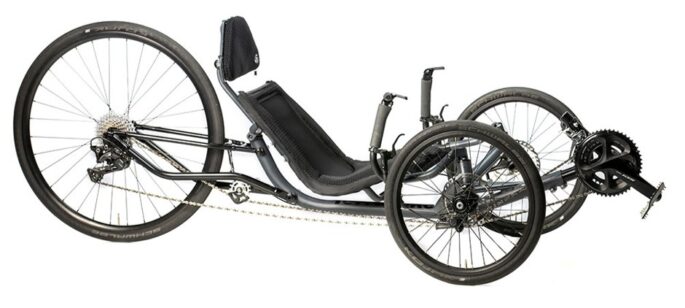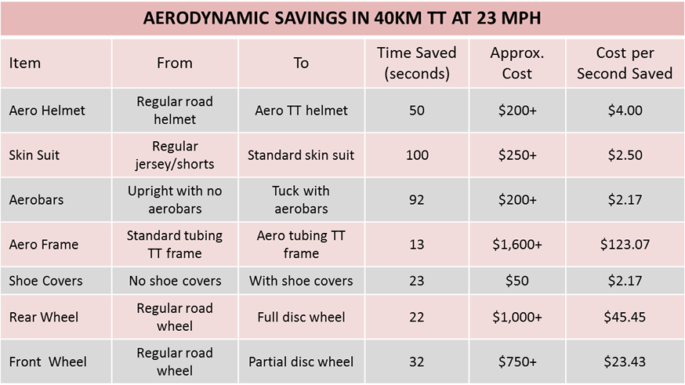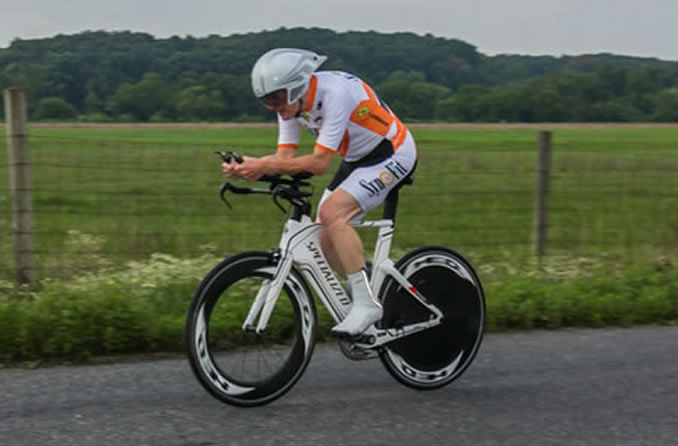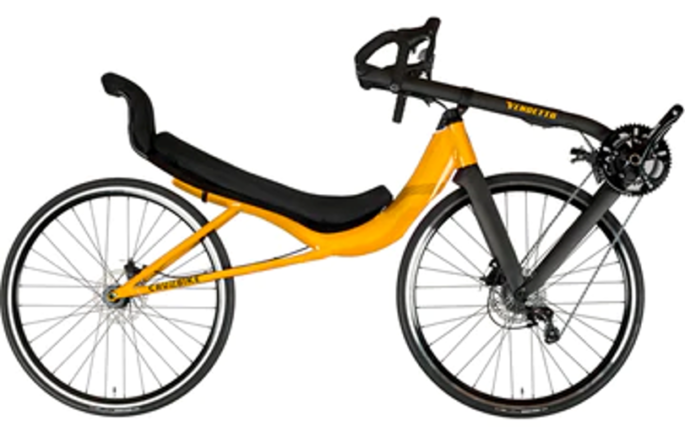My Gear
RACING GEAR
The speed you can achieve on your bike is determined by two factors: how much power you can produce and wind resistance. The faster you go, the more wind drag you need to overcome. Time trial-specific training addresses the power component, while aerodynamic gear helps reduce wind resistance. The table below is adapted from several I’ve seen on online. I’ve recalculated the time savings based on my fastest 40km TT speed to date.
UPDATE: For details about my new time trial bike, see Breaking News #2 and Breaking News #4.
INDOOR TRAINING GEAR
For the past several years, I used my first road bike, Klein Quantum Race, since it has over 50,000 miles on the frame, with a Vittoria Zaffiro Pro trainer tire on the rear wheel, exclusively as my indoor training bike, attached to the Kinetic by Kurt, a fluid resistance unit. However, since acquiring the Wahoo Fitness KICKR Power Trainer in January 2014 (see Breaking News #5), I’m able to use my new TT bike to train indoors. The KICKR replaces the rear wheel, eliminating the need for an indoor training tire. An essential piece of gear is an 18-inch pedestal fan. I use a Cool Breeze 18″ 3-Way Oscillating Pedestal Fan set to the highest speed. Since my indoor workouts last from 30 minutes to over an hour, I have my favorite music playing in the background. I use the live concert videos of my three favorite artists: Loreena McKennitt, Peter Gabriel, and Mark Knopfler. And, finally, I record all of my indoor training workouts with my Garmin Edge 510 bike computer.
WHAT’S THE BOTTOM LINE?
I have an investment in aero gear (all of the above items) of just over $7,000 which has improved my race time by 5 minutes and 32 seconds, the difference between 1:04:00 (23 mph) and 1:09:32 (21.44 mph) in a 40km TT. This is a significant difference. How significant? Recently, the winner of the regional time trial championship, in my new age group, averaged 23.18 mph; the competitor who averaged 21.50 mph finished seventh.
UPDATE #1: I retired my 2005 Specialized Roubaix Elite road bike after the Sunday, June 11, 2017, ride. There was close to 50,000 miles on the frame and the powertrain had been replaced twice. It had a 9-speed cassette with a 53/39 chainring and had been a dependable bike on my weekend rides on the local bike trails, as well as a couple of fast centuries, over the years. It was replaced by a 2017 Specialized Tarmac Comp road bike with a 11-speed cassette and a 52/36 mid-compact chainring. (I donated the Roubaix to a local charity called Dream Bikes in November 2021.)
UPDATE #2: As a result of a horrific collision with an electric scooter at the start of a training ride early Sunday morning, June 27, 2021, I suffered a broken neck and upper back. The resulting surgery fused 15 vertebrae and left me with a 40-degree forward slouch. I can no longer ride my Tarmac or Shiv. Instead I have purchased a recumbent performance trike, the TerraTrike Spyder pictured below, and will start indoor training with it on December 7, 2021.

UPDATE #3: On December 7, 2021, I learned that Illinois is one of 17 states that prohibits recumbent trikes from riding on state highways. This prohibition extends to quad pedal/cargo bikes and handcycles. Two-wheel recumbents are allowed. This is a significant development because 15 of the 19 Mid-America Time Trial Series (MATTS) races are held on Illinois state highways. Only four races are held on Wisconsin roads, where recumbent trikes are allowed. So, I am returning the trike for a full refund. I have two options. First, see if my current race bike cockpit can be modified to raise my head sufficiently, without affecting my center of balance, that I can see the road ahead. Or, secondly, purchase a two-wheel race recumbent. This will be a more difficult task because all of the ones on the market have seats that are too horizontal to accommodate my severe scoliosis. They are also too long to transport in my current SUV. In the meantime, I will resume training with my road bike on a Saris M2 wheel-on smart trainer.

UPDATE #4: Since returning the Spyder, I purchased a state-of-the-art Cruzbike Vendetta V20c racing recumbent in May 2022 after attempts to modify my regular racing bike proved unsuccessful. I was only able to see the road immediately in front of the bike. I needed to be able to see the road at least 100 yards ahead, a distance that we cover in 10 seconds at race speeds in excess of 20 mph. Two modifications to the V20c partially improved my forward visibility. Unfortunately, while my far vision was significantly improved, I could not see the road immediately in front of this bike.
Then, on Friday, June 3, I met with my spine surgeon for my one-year surgery review. I showed him a picture of the V20c and he was horrified. He said that a fall/crash with this bike could shatter my 15 fused vertebrae and leave me paralyzed. He said that the 3.5 pounds of titanium pins and rods in my neck and upper back had shifted my center of balance. He was correct. I have been unable to balance the bike when fully reclined. So, I have posted a “For Sale” notice on the Cruzbikes Forum and received two interested responses within the first hour. My local bike shop has three Spyders in stock. I am also not concerned about the illegality of racing the Spyder on Illinois highways, since it is legal in Wisconsin, Minnesota, Michigan, Indiana, and Iowa, the rest of the Midwest. I’ll just have to travel a bit farther to race it.
Have questions about gear? Chances are pretty good that I’ve faced the same challenges during the last 20+ years of training and racing. Ask me anything!
Categories
Archives



